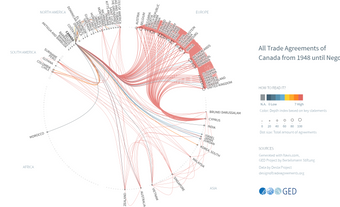Pacific Rim
The term Pacific Rim has been used to refer to all those countries with coastlines bordering the Pacific Ocean. However, in recent years the term has become synonymous with the Asia Pacific region which encompasses East and Southeast Asia, South Asia, Australia, New Zealand and North America. This new terminology reflects a growing sense of regional interdependency and acknowledges the expansion of the economic and political significance of this region in the 20th century.
As a nation with a long Pacific coast Canada has always had some cultural and economic association with the Pacific Rim. Approximately 25,000 years ago, Canada's first inhabitants migrated from Asia across the BERINGIA land bridge. Beginning in the late 15th century, European explorers repeatedly (and unsuccessfully) attempted to find a sea passage through Canada which would lead them to the riches of Asia. In the 18th century, while European settlement and trade commenced on the East Coast, other Europeans initiated trade with Asia from Canada's NORTHWEST COAST. From there, furs and timber were shipped to Asia in return for luxury items such as porcelain and tea.
After the completion of a transcontinental rail link in 1885, Canada was finally able to provide Britain with an alternative passage to its considerable interests in Asia. The building of this railway and the earlier Fraser River GOLD RUSH also coincided with the first significant modern immigration of Asians to Canada. Yet while Asian immigration increased, Canada's cultural identity and economic priorities still were determined by its historic ties with Britain and its population who were mostly of European origin. However, in the post WWII period, as a result of the general process of decolonization and in accordance with an international political and economic shift away from Europe and towards the Asia Pacific region, Canada has also begun to change its cultural identification and economic priorities. Today, Canada's major trading partners are the US and Japan, while Europe has fallen to third place.
As one of the nations most dependent on trade, Canada's continued development is reliant upon success in acquiring new markets for raw materials and manufactured goods. While both the federal government and private business recognize the potential for Canadian markets in the Asia Pacific region, they also recognize that successful development must be accompanied by an improved understanding of the variety of economic, cultural and political factors which influence trading practices in this region. In response to this need Canada participates in regional associations such as the Pacific Basin Economic Council and has established federal and private organizations such as the Canadian National Committee for Pacific Economic Co-operation.
By the year 2000, there will be over 25 megacities in the world with populations of over 10 million people. Thirteen of these cities will be in Asia and only 3 in Europe and North America. It is apparent that Canada's future economic development will depend on its successful identification as a member of the Pacific Rim community of nations.

 Share on Facebook
Share on Facebook Share on X
Share on X Share by Email
Share by Email Share on Google Classroom
Share on Google Classroom

